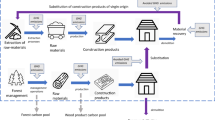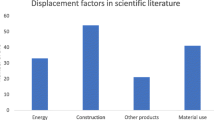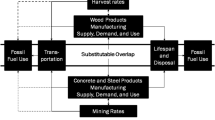Abstract
Increased use of wood can substitute more energy demanding products and thus contribute to a long-term solution to the global warming problem. The aim of this article is to provide an empirical study on this substitution impact, its cost-effectiveness, and which methodological assumptions that are of highest importance for the results obtained. We have made a case study where we compare use of various flooring materials. The results show that floor covering in solid oak causes lower greenhouse gas (GHG) emissions than the other materials. The difference can be ranked in the following order, after their potential for reduction in GHG emissions: Carpet in wool, carpet in polyamide, vinyl, and linoleum. At 2% pro anno discount rate, the avoided GHG emission in tons per m3 of oak flooring used is 0.1–1.9 for linoleum, and 11.8–15.5 for wool carpets. Unless the solution in solid oak is on total less expensive over the lifetime of the building, only the price of avoided emissions from a substitution between solid oak and carpet in wool is reasonable, compared to present carbon fees. The assumptions that influence the result most are choice of discount rate, carbon fixation on forest area, and waste handling. Empirical case studies like this indicate GHG emission reduction potentials caused by substitution, but should be complemented by dynamic input/output analyses and econometric studies. To analyse the flow of CO2 over time, they should also be linked to forest management models.
Similar content being viewed by others
References
Apneseth, T.: 1997a, 'Environmental Declaration of Products from the Wood Industry, Main Report (Miljødeklarasjon av treindustriens produkter, hovedrapport)', Norwegian Institute for Wood Technology (Norsk Treteknisk Institutt), Oslo, Norway (in Norwegian).
Apneseth, T.: 1997b, 'Environmental Declaration of Products from theWood Industry, Supplement to Main Report (Miljødeklarasjon av treindustriens produkter, bilag til hovedrapport)', Norwegian Institute of Wood Technology (Norsk Treteknisk Institutt), Oslo, Norway (in Norwegian).
Aune, F. R., Bye T., and Johnsen, T. A.: 2000, Gas Power Generation in Norway: Good or Bad for the Climate?, Statistics Norway, Research Department, Oslo, Norway.
Björklund, T., Jönsson, Å., and Tillman, A.-M.: 1996, 'LCA of Building Frame Structures. Environmental Impact over the Life Cycle of Concrete and Steel Frames', Chalmers University of Technology, Göteborg, Sweden.
Björklund, T. and Tillman, A.-M.: 1997, 'LCA of Building Frame Structures. Environmental Impact over the Life Cycle of Wooden and Concrete Frames', Chalmers University of Technology, Göteborg, Sweden.
Börjesson, P. and Gustavsson, L., 2000, 'Greenhouse Gas Balances in Building Construction: Wood versus Concrete from Life-Cycle and Forest Land-Use Perspectives', Energy Policy 28, 575–588.
Consoli, F.: 1993, Guidelines for Life-Cycle Assessment. A 'Code of Practice', Society of Environmental Toxicology and Chemistry, Brussels, Belgium.
Deutsche Gesellschaft für Holzforschung: 2001, Wood-the Material for the Future (Holz-Rohstoff der Zukunft) (in German).
ECON: 1995, Effects on Climate Change from Increased Use of Wood (Klimamessige virkninger av økt bruk av trevirke), Oslo, Norway (in Norwegian).
Engberg, P. and Eriksson, E: 1998, LCA of Railway Sleepers-A Comparative Life Cycle Analysis of Sleepers in Concrete and Wood (LCA av sliprar-en jamförande livscykelanalys av betong-og träsliper), Chalmers Industriteknik, Göteborg, Sweden (in Swedish).
Engelbertsson, T.: 1997, LCA of Roof Constructions in a Sports Centre (Livscykelvärdering av alternativa takkonstruktioner i bandyhall), Royal Institute of Technology, Department of Structural Engineering (Kungliga Tekniska Högskolan, Institutionen för byggkonstruktion), Stockholm, Sweden (in Swedish).
Erlandsson, M.: 1996, Methodology for Environmental Assessment ofWood-Based Products. General and Specific Questions Related to the Life Cycle Inventory, Trätek, Stockholm, Sweden.
Fankhauser, S.: 1994, 'The Social Cost of Greenhouse Gas Emissions: An Expected Value Approach', Energy J. 15 (2), 157–184.
Fossdal, S.: 1995, Energy-and Environmental Accountance of Buildings (Energi-og miljøregnskap for bygg. Fremstilling av byggematerialer. Regnskap for boliger og kontorbygg), Norwegian Building Research Institute (Norges Byggforskningsinstitutt), Oslo, Norway (in Norwegian).
Hammitt, J. K., Jain, A. K., Adams, J. L., and Wuebbles, D. J.: 1996, 'A Welfare-Based Index for Assessing Environmental Effects of Greenhouse-Gas Emissions', Nature 381, (May), 301–303.
Hoen, H. F. and Solberg, B.: 1995, 'On “Valuation of Global Afforestation Programs for Carbon Mitigation”, by Sten Nilsson. An Editorial Comment', Clim. Change 30, 259–266.
Hoen, H. F. and Solberg, B.: 1997, 'CO2 Taxing, Timber Rotations andMarket Implications', Critical Reviews in Environmental Science and Technology 27 (1), 151–162.
IPPC: 1995, Radiative Forcing of Climate Change and an Evaluation of the IPCC IS92 Emission Scenarios, Cambridge University Press.
Jarnehammar, A.: 1998, 'Comparative LCA-Floor and External Walls (Jamförande livscykelanalys-bjälklag och ytterväggar)', Trätek, Stockholm, Sweden (in Swedish).
Jönsson, Å., Svensson T., and Tillman, A.-M.: 1995, Life-Cycle Assessment of Flooring Materials: A Comparison of Linoleum, Vinyl Flooring and Solid-Pine Flooring, Swedish Council for Building Research (Byggforskningsrådet), Stockholm, Sweden.
Kandlikar, M.: 1996, 'Indices for Comparing Greenhouse Gas Emissions: Integrating Science and Economics', Energy Economics 18, 265–281.
Kristensen, T.: 1999, LIFE-SYS WOOD. LCA of Warehouse Frame, Paper LCA of Product No. 2. In print, Norwegian Institute of Wood Technology (Norsk Treteknisk Institutt), Oslo, Norway.
Künniger, T. and Richter, K.: 1998, 'Comparative Life Cycle Assessment of Swiss Railroad Sleepers', EMPA, Dübendorf, Switzerland.
Lashof, D. A. and Ahuja, D. R.: 1990, 'Relative Contributions of Greenhouse Gas Emissions to Global Warming', Nature 344, (April), 529–531.
Lindfors, L.-G.: 1995, Nordic Guidelines on Life-Cycle Assessment, Nordic Council of Ministers, Copenhagen, Denmark.
Mørkved, K. and Opdal, T.: 1990, 'Energy Resource-Accountance for Wood as Building Material (Energiressurs-regnskap for trevirke som bygningsmateriale)', Norwegian Institute of Wood Technology (Norsk Treteknisk Institutt), Oslo, Norway (in Norwegian).
Norwegian Ministry of the Environment: 2000, A Quota System for Greenhouse Gases (Et kvotesystem for klimagasser), Statens forvaltningstjeneste, Oslo, Norway (in Norwegian).
Petersen, A. K. and Solberg, B.: 2002a, 'Energy Consumption, Greenhouse Gas Emissions, and Cost-Efficiency of Using Floorboards in Solid Oak Compared to Five Alternative Floor Solutions (Energiforbruk, klimagassutslipp og kostnadseffektivitet ved bruk av gulvbord i heltre eik sammenlignet med fem alternative gulvløsninger)', Rapport fra skogforskningen, 2002, (2) (in Norwegian).
Petersen, A. K. and Solberg, B.: 2002b, 'Greenhouse Gas Emissions, Life-Cycle Inventory and Cost-Efficiency of Using LaminatedWood Instead of Steel Construction. Case: Beams at Gardermoen Airport', Environmental Science &; Policy 5 (2), 169–182.
Petersen, A. K. and Solberg, B.: 2003, 'Environmental and Economic Impacts of Substitution between Wood Products and Alternative Materials: A Review of Micro-Level Analyses from Norway and Sweden', J. of Forest Policy and Economics (accepted).
Potting, J. and Blok, K.: 1995, 'Life-Cycle Assessment of Four Types of Floor Covering', J. of Cleaner Production 3 (4), 201–213.
Reilly, J. M. and Richards, K. R.: 1993, 'Climate Change Damage and the Trace Gas Index Issue', Environ. Resour. Econ. 3, 41–61.
Scharai-Rad, M. and Welling, J.: 2002, Environmental and Energy Balances of Wood Products and Substitutes, FAO, Rome, Italy.
Schmalensee, R.: 1993, 'Comparing Greenhouse Gases for Policy Purposes', Energy J. 14, 245–255.
Solberg, B.: 1997, 'Forest Biomass as Carbon Sink-Economic Value and Forest Management/Policy Implications', Critical Reviews in Environmental Science and Technology 27, 323–333.
Tol, R. S. J.: 1999, 'The Marginal Costs of Greenhouse Gas Emissions', Energy J. 20 (1), 61–81.
Author information
Authors and Affiliations
Rights and permissions
About this article
Cite this article
Petersen, A.K., Solberg, B. Greenhouse Gas Emissions and Costs over the Life Cycle of Wood and Alternative Flooring Materials. Climatic Change 64, 143–167 (2004). https://doi.org/10.1023/B:CLIM.0000024689.70143.79
Issue Date:
DOI: https://doi.org/10.1023/B:CLIM.0000024689.70143.79




